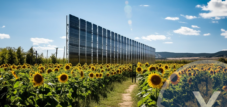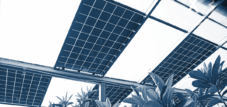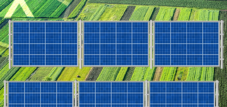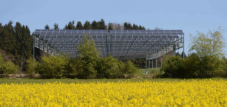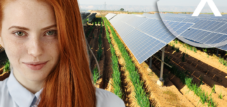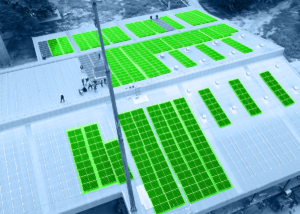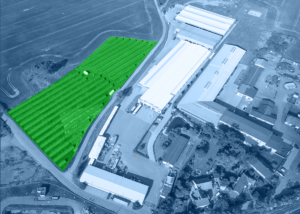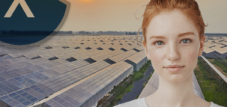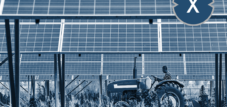Double harvesting under the sun with agri-photovoltaics: The synergy of agri-PV systems and modern agriculture
Language selection 📢
Published on: March 11, 2024 / Update from: March 12, 2024 - Author: Konrad Wolfenstein
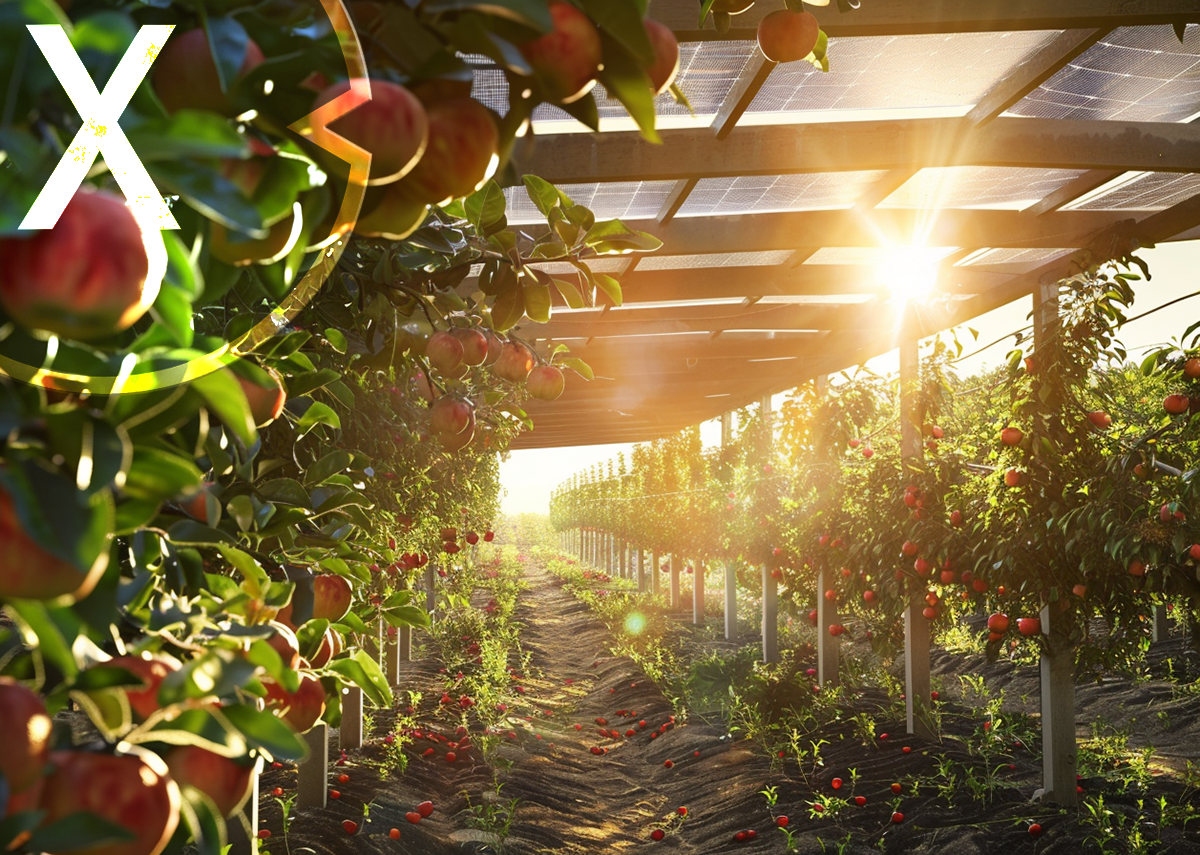
Economic efficiency meets ecology: Agri-PV as a future model for resilient farms – Image: Xpert.Digital
🌱 Agri-photovoltaics in modern agriculture 🌞
📚 The integration of agri-photovoltaics (agri-PV) in modern agriculture represents an innovative step towards more sustainable and resilient agricultural production, coupled with the efficient production of renewable energy. Agri-PV, the symbiosis of agricultural use and photovoltaic electricity production on the same area, not only leads to the optimization of land use, but also addresses significant challenges of the 21st century such as climate change, energy transition and food security.
☀️ Efficient use of agricultural land
A core aspect of Agri-PV is the efficient use of agricultural land. By combining solar energy production and agriculture on the same piece of land, not only can energy needs be met, but agricultural goods can also be produced at the same time. This reduces competition for valuable land and enables multifunctional use of land, which is both economically and ecologically beneficial.
💧 Advantage: Reduced water consumption
Another important advantage of Agri-PV systems is their potential to reduce water consumption in agriculture. The shaded areas created by solar panels can minimize evaporation, thereby reducing the water needs of plants. In addition, the structures provide protection from extreme weather events such as hail or storms, which can result in reduced use of protective materials.
💰 Financial aspects of Agri-PV
The financial aspects of Agri-PV are no less important. By installing Agri-PV systems, farms open up an additional source of income that contributes to the economic viability of the farm. This can provide important financial support and increase the economic resilience of the business, especially in times of crop failure or fluctuating market prices.
🌍 Global examples and achievements
There are already successful examples in Germany and around the world that illustrate the potential of Agri-PV. Projects in the USA, France and Chile show that the technology can be adapted and successfully implemented worldwide. These pioneers impressively demonstrate how Agri-PV contributes to overcoming global challenges.
📘 Planning and regulations in Germany
A crucial factor for the successful use of Agri-PV is the adequate planning and implementation of the systems. In Germany, this is regulated by DIN SPEC 91434:2021-05, which, among other things, classifies systems into high-elevation and ground-level systems and sets minimum standards with regard to the permitted loss of arable land and the average yield to be achieved from a crop. In addition, agricultural usage concepts must be developed and checked by certified companies, which paves the way for the successful integration of Agri-PV.
🌱 Funding and political framework conditions
Promoting Agri-PV through political and regulatory frameworks is essential. The amendment to the law and the possibility of receiving bonuses for agri-PV systems This applies to both large-scale, high-mounted systems and smaller installations.
🚧 Challenges and future prospects
Despite the continued success of agri-PV, both farmers and society face challenges. This primarily includes the sometimes complex approval procedures and the initial investments required for the implementation of agri-PV systems. Future developments and research efforts are critical to overcome these hurdles and make the technology even more widely available.
🌟 Innovative technology in agriculture
The future of Agri-PV looks promising. The integration of this innovative technology into agriculture has the potential to bring significant benefits for the energy transition, the environment and the agricultural economy. Agri-PV systems can play a key role in the transformation to a more sustainable and resilient society, not only contributing to carbon savings and climate protection, but also promoting agricultural productivity and diversification of income sources for farmers. However, to fully realize this potential requires continued research, innovation and supportive policies.
🎯 Interesting links
- Association of German Engineers eV – electricity generation on agricultural land
- Fraunhofer Institute for Solar Energy Systems ISE – Agri-photovoltaics: better opportunities for smaller systems and high-mounted systems
📣 Similar topics
- 🌞 Agri-photovoltaics: innovation in agriculture
- 🍃 More than energy: The advantages of Agri-PV systems
- 💧 Saving water with Agri-PV: A win-win situation
- 💰 Financial opportunities through agri-photovoltaics
- 🌍 Global success stories: Agri-PV in action
- 📐 Crucial for success: planning agri-PV systems
- 📜 Setting the political course: promoting agri-PV
- 🚜 Challenges and solutions for farmers in Agri-PV
- 🔍 Future of Agri-PV: Research and Development
- 🌱 Sustainability and profitability: The Agri-PV duo
#️⃣ Hashtags: #AgriPhotovoltaics #RenewableEnergy #SustainableAgriculture #EnergyTransition #InnovationInTheAgriculture
📌 Other relevant topics on agri-photovoltaics (agri-PV)
🌾 The CAP premium: the heart of EU agricultural funding
📚🌾 The importance of the CAP premium in the EU
The CAP premium (Common Agricultural Policy) is an essential component of agricultural support within the European Union. The Common Agricultural Policy (CAP) was established in 1962 to ensure food security, stabilize agricultural incomes and support rural development in the EU. The aim is to promote sustainable agriculture that is both economically viable and meets ecological and social criteria.
Suitable for:
💰 Two pillars of the GAP premium
🌱 1. Direct payments (first pillar)
These include income support for farmers who meet certain environmental, climate and animal welfare standards. These direct payments are intended to provide farmers with a basic income and are often area-based. They are intended to increase farmers' income security and help compensate for fluctuations in market income.
🏡 2. Rural development measures (second pillar)
These aim to strengthen the economic viability of rural areas and include investments in the modernization of agriculture, in environmental management, in the development of rural areas and in the diversification of the rural economy. The measures in this pillar are often co-financed by national or regional governments and the EU.
🔄 The new CAP strategic plan 2023-2027
🌍 Adjustments and focus
The exact structure and amount of the CAP premiums can vary depending on the EU program period, national strategic plans and specific regulations of the member states. With the new CAP Strategic Plan 2023-2027, which focuses more on environmental and climate objectives, changes to the distribution and criteria for granting the premiums also come into force. The focus on more sustainable agriculture and greater consideration of environmental protection and animal welfare are important aspects.
🌱 Sustainability and support from GAP
🤝 An important financial support
The CAP premiums provide important financial support for many farmers in the EU to meet the challenges of modern agriculture while promoting public goods such as environmental and animal welfare.
📣 Similar topics
- 🍀 Sustainable practices in EU agriculture through the CAP
- 🌍 The role of the CAP in Europe's food security
- 💶 Financial support for farmers: A look at CAP direct payments
- 🌱 Promoting rural development: The second pillar of the CAP
- 🔄 How the new CAP strategy 2023-2027 is changing Europe's agriculture
- 💡 Investing in the future: modernizing agriculture through CAP
- 🐾 Animal welfare and environmental protection: priorities of the new CAP
- 📈 Strengthening the income security of European farmers through the CAP
- 🌳 CAP measures to support organic farming
- 📊 Analysis of CAP premium distribution in the EU
#️⃣ Hashtags: #CAP2027 #EU_Agriculture #SustainableAgriculture #RuralDevelopment #EuropeanUnion

Partially transparent solar modules for Agri-PV are already in use
Partially transparent solar modules are already being used in a research facility in the “Model Region Agri-Photovoltaics Baden Württemberg”.
More about it here:
Plan your solar system for the most common applications conveniently online with our solar system planner!
With our user-friendly solar system planner you can plan your individual solar system online. Whether you need a solar system for your home, your business or for agricultural purposes, our planner offers you the opportunity to take your specific requirements into account and develop a tailor-made solution.
The planning process is simple and intuitive. You simply enter relevant information. Our planner takes this information into account and creates a tailor-made solar system that meets your needs. You can try out different options and configurations to find the optimal solar system for your application.
Additionally, you can save your plan to review later or share with others. Our customer service team is also available to answer your questions and provide support to ensure your solar system is optimally planned.
Use our solar system planner to plan your individual solar system for the most common applications and advance the transition to clean energy. Start now and take an important step towards sustainability and energy independence!

The solar system planner for the most common applications: Plan the solar system online here - Image: Xpert.Digital
More about it here:
🌱🌞 Agri-photovoltaics (agri-PV)
📚 Agri-photovoltaics (agri-PV) represents an innovative connection between agriculture and the production of solar energy, with both forms of use taking place on the same area. DIN SPEC 91434:2021-05 specifies this connection through detailed guidelines and standards to ensure harmonious coexistence and efficient use of agricultural areas. The special feature of Agri-PV systems lies in their ability to combine agricultural production with sustainable energy production, which in turn contributes to energy and food security.
🌾🌞 Classification of Agri-PV systems
A distinction is made between high-mounted and ground-level Agri-PV systems. In the former, the lower edge of the solar modules is at least 2.10 meters above the ground, which gives space for agricultural work processes as well as the growth of plants or animal husbandry under the modules. Ground-level systems, on the other hand, are installed closer to the ground and offer a different way of using the space. A key aspect of this innovation is that it prioritizes agricultural productivity. For ground-level systems, a maximum of 15% and for high-mounted systems a maximum of 10% of the usable agricultural area may be lost through the installation. It is also stipulated that at least two thirds of the previous average yield of an agricultural crop must be achievable even after the installation of the Agri-PV system.
📄🌻 Sustainable coexistence and certification
In order to ensure sustainable coexistence, the development of an agricultural usage concept is necessary. This includes detailed information on land use, technical details of the Agri-PV system, possible loss of agricultural land and forecasts for crop production for the next three years. Certification of this concept by recognized companies ensures that the specified standards are met.
🐑🌞 Agri-PV and pasture farming
The combination of agri-PV systems with pasture farming represents another interesting approach, which has not yet been conclusively defined. It is expected that a related pre-standard will be published in mid-2024, opening up new perspectives for multifunctional land use.
💸🔍 Challenges and funding
Despite the innovative potential of agri-PV, research faces challenges, particularly in determining which systems are best suited for specific agricultural crops. In addition, higher investment costs can arise compared to conventional PV ground-mounted systems, especially with high-elevation systems due to the higher use of materials. A technology bonus was introduced as a compensation mechanism, the future effectiveness of which in covering these additional costs remains to be assessed.
📈🌿 Approval process and legal framework
The implementation of agri-PV systems is also made more difficult by sometimes lengthy approval procedures. The necessary change to the land use plan and the preparation of a development plan by the municipalities can be a time-consuming process. In order to accelerate this, legal adjustments were made which enable the privileged treatment of Agri-PV systems under certain circumstances and should lead to a shortening of the approval time.
🌏🍀 Future prospects
Despite the obvious advantages and funding potential, there are still some hurdles to the comprehensive implementation of agri-PV. These include not only the aforementioned higher investment costs and approval challenges, but also the need to further optimize the technology to expand its applicability to diverse agricultural crops and systems. Nevertheless, Agri-PV offers a promising perspective for a sustainable future in which the parallel use of land for food production and the generation of renewable energy plays a key role. A comprehensive understanding of the technical, ecological and economic aspects is essential to fully exploit the potential of Agri-PV and contribute to achieving global climate goals.
🎯 Interesting links
- Association of German Engineers eV – electricity generation on agricultural land
- Baden Agricultural Association eV Privileges for small agri-PV systems
📣 Similar topics
- 🌱 The future of agriculture: Agri-PV
- 🌞 Solar energy in agriculture: A sustainable connection
- 💡 Innovative Agri-PV systems: High-mounted vs. ground-level systems
- 📋 The importance of DIN SPEC 91434:2021-05 for Agri-PV
- 💼 Certification process for Agri-PV systems: An overview
- 🐑 Agri-PV and pasture farming: A symbiosis in development
- 💰 Financing hurdles and technology bonus for Agri-PV
- 🚜 Agricultural productivity under Agri-PV systems
- 🏛 Agri-PV approval process: challenges and solutions
- 💡 Agri-PV as a pioneer for a sustainable future
#️⃣ Hashtags: #AgriPhotovoltaics #SustainableAgriculture #SolarEnergyInTheAgriculture #InnovationInTheAgriculture #FutureOfEnergyProduction
🎯🎯🎯 Benefit from Xpert.Digital's extensive, fivefold expertise in a comprehensive service package | R&D, XR, PR & SEM

AI & XR 3D Rendering Machine: Fivefold expertise from Xpert.Digital in a comprehensive service package, R&D XR, PR & SEM - Image: Xpert.Digital
Xpert.Digital has in-depth knowledge of various industries. This allows us to develop tailor-made strategies that are tailored precisely to the requirements and challenges of your specific market segment. By continually analyzing market trends and following industry developments, we can act with foresight and offer innovative solutions. Through the combination of experience and knowledge, we generate added value and give our customers a decisive competitive advantage.
More about it here:
- Warehouses, production halls and industrial halls with their own power source from a photovoltaic roof system - Image: NavinTar|Shutterstock.com
- Industrial plant with its own power source from an outdoor photovoltaic system - Image: Peteri|Shutterstock.com
- Plan solar systems with photovoltaic solutions for freight forwarding and contract logistics
- B2B solar systems and photovoltaic solutions & advice
- Plan photovoltaics for warehouses, commercial halls and industrial halls
- Industrial plant: Plan a photovoltaic open-air system or open-space system
- Plan solar systems with photovoltaic solutions for freight forwarding and contract logistics
- B2B solar systems and photovoltaic solutions & advice
We are there for you - advice - planning - implementation - project management
☑️ Construction and advice on photovoltaic open-space systems
☑️ Solar park planning ☑️ Agri-photovoltaic implementation
☑️ Solar outdoor systems with dual-use solutions
Xpert.Solar is your ideal partner for the planning, consulting and construction implementation of ground-mounted photovoltaic systems and agricultural photovoltaic projects due to our many years of experience and expertise in the solar energy industry. Xpert.Solar has an experienced team of professionals that offers tailored solutions to farmers and investors. From location analysis to financial and legal advice to technical implementation and monitoring, Xpert.Solar supports its customers professionally and reliably to ensure successful and sustainable implementation.
I would be happy to serve as your personal advisor.
You can contact me by filling out the contact form below or simply call me on +49 89 89 674 804 (Munich) .
I'm looking forward to our joint project.
Xpert.Digital - Konrad Wolfenstein
Xpert.Digital is a hub for industry with a focus on digitalization, mechanical engineering, logistics/intralogistics and photovoltaics.
With our 360° business development solution, we support well-known companies from new business to after sales.
Market intelligence, smarketing, marketing automation, content development, PR, mail campaigns, personalized social media and lead nurturing are part of our digital tools.
You can find out more at: www.xpert.digital - www.xpert.solar - www.xpert.plus



